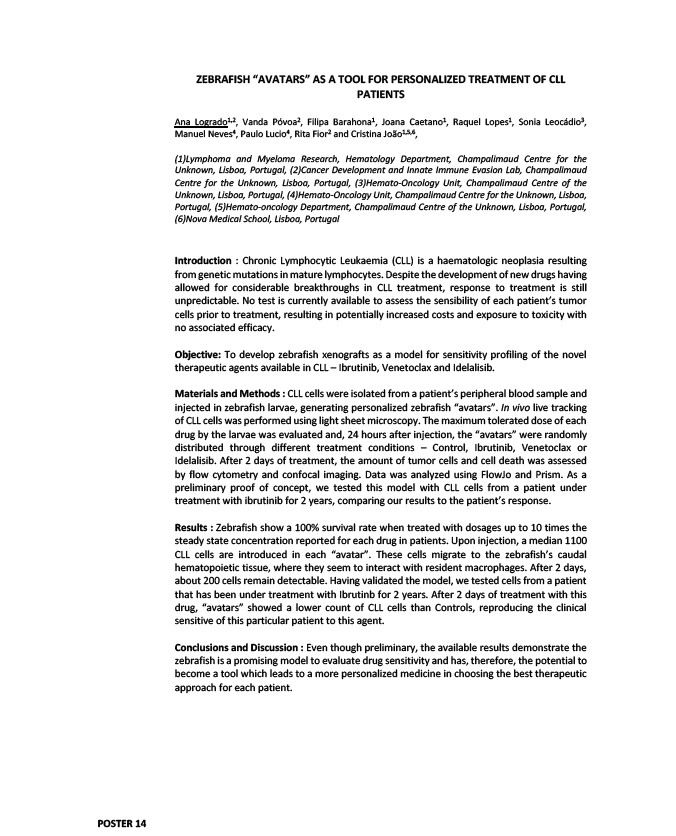
ZEBRAFISH “AVATARS” AS A TOOL FOR PERSONALIZED TREATMENT OF CLL
PATIENTS
Ana Logrado1,2, Vanda Póvoa2, Filipa Barahona1, Joana Caetano1, Raquel Lopes1, Sonia Leocádio3,
Manuel Neves4, Paulo Lucio4, Rita Fior2 and Cristina João1,5,6,
(1)Lymphoma and Myeloma Research, Hematology Department, Champalimaud Centre for the
Unknown, Lisboa, Portugal, (2)Cancer Development and Innate Immune Evasion Lab, Champalimaud
Centre for the Unknown, Lisboa, Portugal, (3)Hemato-Oncology Unit, Champalimaud Centre of the
Unknown, Lisboa, Portugal, (4)Hemato-Oncology Unit, Champalimaud Centre for the Unknown, Lisboa,
Portugal, (5)Hemato-oncology Department, Champalimaud Centre of the Unknown, Lisboa, Portugal,
(6)Nova Medical School, Lisboa, Portugal
Introduction : Chronic Lymphocytic Leukaemia (CLL) is a haematologic neoplasia resulting
from genetic mutations in mature lymphocytes. Despite the development of new drugs having
allowed for considerable breakthroughs in CLL treatment, response to treatment is still
unpredictable. No test is currently available to assess the sensibility of each patient’s tumor
cells prior to treatment, resulting in potentially increased costs and exposure to toxicity with
no associated efficacy.
Objective: To develop zebrafish xenografts as a model for sensitivity profiling of the novel
therapeutic agents available in CLL – Ibrutinib, Venetoclax and Idelalisib.
Materials and Methods : CLL cells were isolated from a patient’s peripheral blood sample and
injected in zebrafish larvae, generating personalized zebrafish “avatars”. In vivo live tracking
of CLL cells was performed using light sheet microscopy. The maximum tolerated dose of each
drug by the larvae was evaluated and, 24 hours after injection, the “avatars” were randomly
distributed through different treatment conditions – Control, Ibrutinib, Venetoclax or
Idelalisib. After 2 days of treatment, the amount of tumor cells and cell death was assessed
by flow cytometry and confocal imaging. Data was analyzed using FlowJo and Prism. As a
preliminary proof of concept, we tested this model with CLL cells from a patient under
treatment with ibrutinib for 2 years, comparing our results to the patient’s response.
Results : Zebrafish show a 100% survival rate when treated with dosages up to 10 times the
steady state concentration reported for each drug in patients. Upon injection, a median 1100
CLL cells are introduced in each “avatar”. These cells migrate to the zebrafish’s caudal
hematopoietic tissue, where they seem to interact with resident macrophages. After 2 days,
about 200 cells remain detectable. Having validated the model, we tested cells from a patient
that has been under treatment with Ibrutinb for 2 years. After 2 days of treatment with this
drug, “avatars” showed a lower count of CLL cells than Controls, reproducing the clinical
sensitive of this particular patient to this agent.
Conclusions and Discussion : Even though preliminary, the available results demonstrate the
zebrafish is a promising model to evaluate drug sensitivity and has, therefore, the potential to
become a tool which leads to a more personalized medicine in choosing the best therapeutic
approach for each patient.
POSTER 14